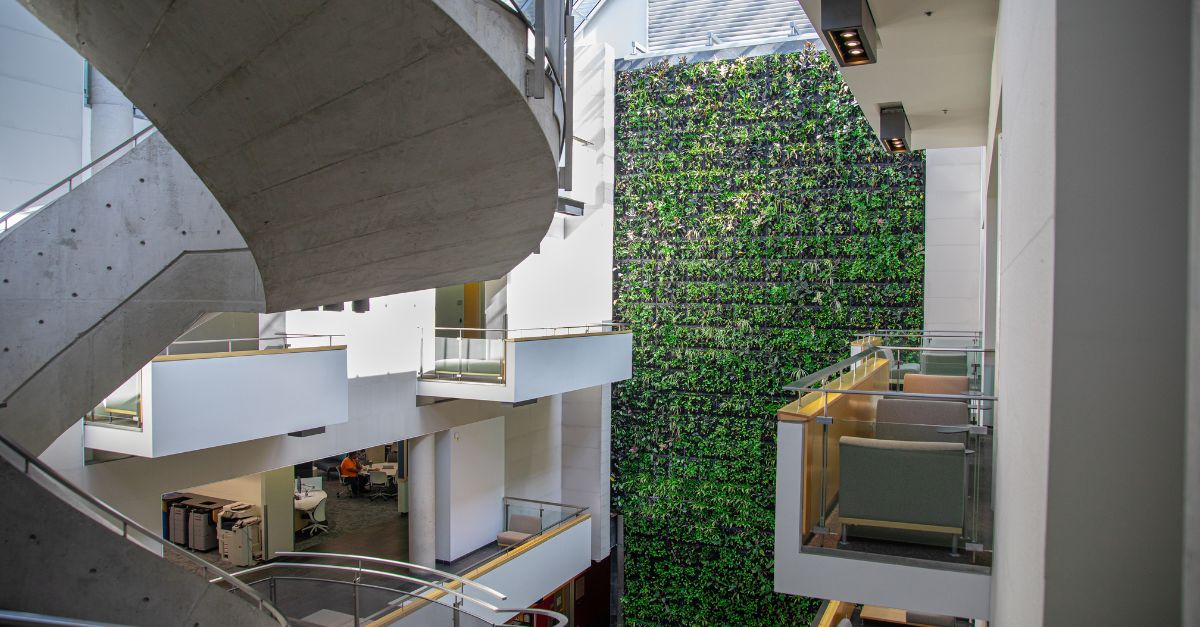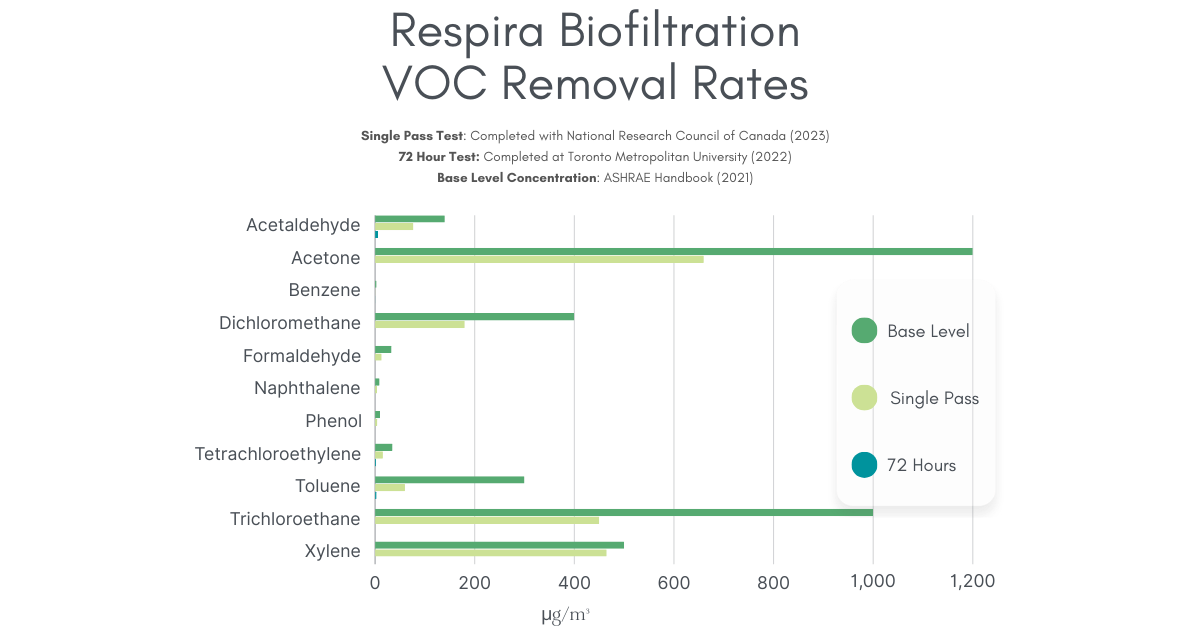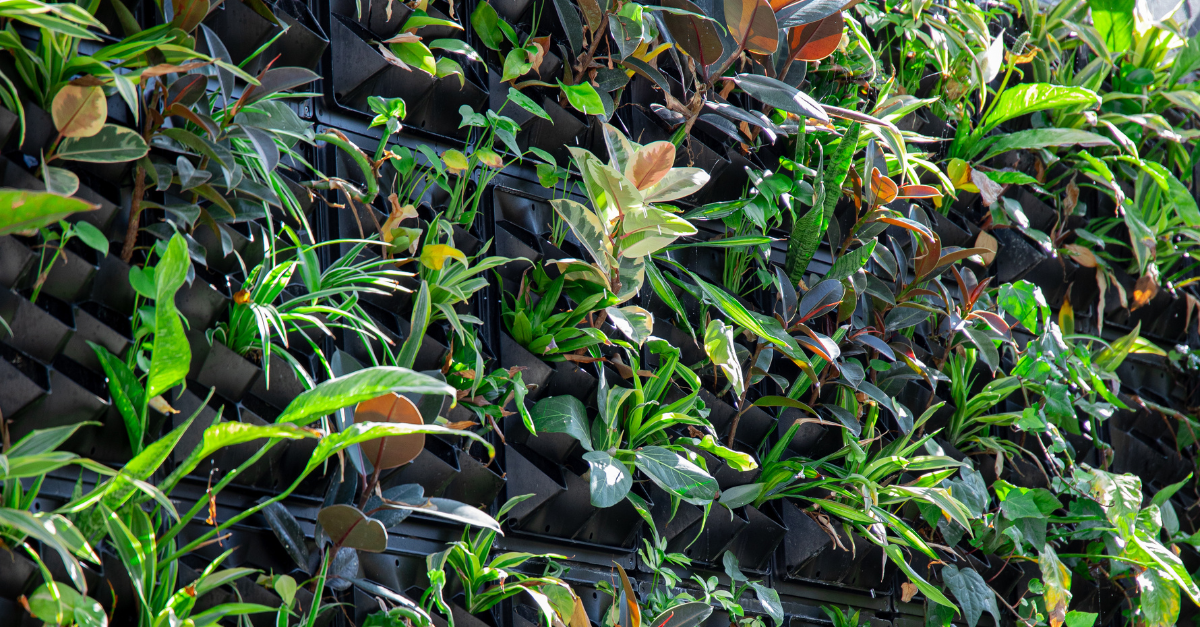In 2022, Guelph-Humber recognized that the living wall within the campus’ central atrium had reached the end of its life cycle. The 57 ft. tall, 30 ft. wide living wall was originally installed in 2003 and contained over 100 different plant species. Over the years it had grown lush and dense however the infrastructure behind the wall was aging and needed to be replaced.

BACKGROUND
CHALLENGES
With sustainability and longevity at the forefront of the university’s objectives, a new solution was sought that would not only restore the living wall to its former glory but also enhance its functionality as a sustainable and low-maintenance feature.
OBJECTIVES
- Rebuild and replant the living wall to restore its aesthetic benefits.
- Upgrade the system to align with sustainability goals.
- Implement automation to reduce manual maintenance requirements.
SOLUTION
To address these challenges and achieve the outlined objectives, Guelph-Humber opted to implement an HVAC-integrated biofilter living wall (Respira biofilter) designed and manufactured by New Earth Solutions. This innovative approach restored the living wall’s beauty while also contributing to the institution’s commitment to environmental responsibility.
The HVAC integration provides improved air quality within the building without increasing the energy consumption of the ventilation unit, helping to avoid increasing Greenhouse Gas (GHG) emissions while improving the health of the building.
Sensors and New Earth’s smart technology were installed to monitor and manage the living wall’s water cycle, nutrient distribution, and overall health. This approach significantly reduced the need for manual intervention, ensuring that the living wall can flourish with minimal maintenance.
TESTING METHODOLOGY
VENTILATION RATE PROCEDURE (VRP) WITHIN ASHRAE STANDARDS:
INDOOR AIR QUALITY PROCEDURE (IAQP) – THE BESPOKE APPROACH:
The Indoor Air Quality Procedure (IAQP) offers a more customized approach to ventilation requirements, considering specific pollutants and their respective limits. This approach involves identifying the sources of indoor pollutants, determining their emission rates, and then calculating the ventilation required to maintain acceptable indoor air quality. Lowering these emissions can be done through traditional ventilation or alternative filtration methods such as the Respira biofilter.
ADVANTAGES OF IAQP OVER VRP:
Holistic Consideration: VRP primarily focuses on occupancy, while IAQP considers a broader range of contaminants. This holistic approach ensures that the ventilation system addresses various pollutants, promoting a healthier indoor environment overall.
Adaptability: IAQP accommodates different building uses and occupancies, making it suitable for diverse environments. It considers variations in emission rates and acceptable concentrations, providing flexibility in ventilation design.
Long-Term Effectiveness: IAQP is often considered more forward-thinking, as it takes into account changes in building use, occupancy patterns, and emerging pollutants. This adaptability ensures that ventilation strategies remain effective over the long term.
APPLICATION
While both VRP and IAQP are recognized methodologies, the IAQP offers a more comprehensive and adaptable approach, considering a wider array of factors for determining ventilation requirements based on indoor air quality goals.
In a 3rd party study with the National Research Council of Canada, New Earth Solutions’ Respira biofilter was tested for its removal efficiency of the contaminants of concern listed by ASHRAE. Showing an overall reduction of contaminants between 18-98% has allowed the Respira biofilter to become a filtration alternative for buildings looking to improve indoor air quality through the use of natural biofilters using the IAQP formula to calculate ventilation.

In Guelph Humber’s case, six 3ft x 3ft ducts are positioned behind the Respira biofilter living wall and use the building’s existing HVAC system to draw air across the face of the plants and into the root zone, before dispersing that air back into the ventilation system for the rest of the building. The importance behind pushing the air into the root zone of plants is that a plant’s ability to break down toxins exists within the root zone where a build-up of microbes and beneficial bacteria break down the contaminants of concern.
IMPLEMENTATION OF AUTOMATION:
Implemented A More Precise Watering & Pump Cycle
- Reduced water consumption by an impressive 45%.
Replaced Halogen Lights With Energy-Efficient LED Grow Lights
- Achieved an 80% reduction in energy consumption related to the grow lights.
Integration Of Monitoring Sensors
- Installed integrated sensors for real-time monitoring of wall health.
- Parameters monitored include water temperature, water flow in GPM (gallons per minute), and ballast temperatures in the basin.
Ballasts For Temperature Control
- Incorporated ballasts in the basin to regulate water temperature.
- Ensured an optimal environment for plant growth and system efficiency.
Pressure Regulation & Monitoring
- Installed pressure regulators to maintain consistent pressure.
- Integrated pressure sensors to ensure alignment with the specified GPM in irrigation lines.
Flow Regulators In Irrigation Lines
- Introduced flow regulators in irrigation lines for precise water distribution.
- Improved water efficiency and reduced waste through controlled flow.
Modernization Of Basket Lift
- Replaced the existing bulky basket lift with a modular, electrical Bosun chair.
- Achieved cost savings of $15,000 per year in certification costs.
- Realized additional annual savings of $40,000 in reduced time on site during maintenance.
RESULTS
SOCIAL:
By restoring the living wall and bringing the beauty of nature back into the built environment, students were able to return to campus after the COVID-19 pandemic to a fresh, bright and lively feeling atrium. In interviews, student Ashna Narumathan stated “The plant wall is an integral part of our campus because it represents what the University of Guelph Humber is all about. You’re not walking into a school, you’re walking into a place you want to be, with teachers and friends.”
The improved indoor air quality facilitated by the Respira biofilter also has direct implications for the physical health of occupants such as the reduction in headaches, dizziness, respiratory illness, and “brain fog”.
Beyond the tangible environmental benefits, the living wall fosters an environment that promotes the physical and mental well-being of individuals by creating a space where students and faculty can immerse themselves in the revitalizing effects of nature. The experience of connecting with nature within an educational space contributes to reduced stress, increased productivity, and a heightened sense of comfort and satisfaction among students.
SUSTAINABILITY:
The installation of the Respira biofilter living wall emerged as a transformative and comprehensive solution for the Univeristy of Gueph-Humber, not only restoring the aesthetic appeal of the living wall and the health benefits of occupants’ connecting with nature but also contributing significantly to the institution’s sustainability goals.
By harnessing the natural air-purifying capabilities of the living wall’s vegetation, the Respira biofilter has mitigated the presence of pollutants, creating a healthier indoor environment in the University’s central atrium. This strategic integration effectively filters 16,620 CFM (cubic feet per minute) of indoor air, annually saving:

LOWER OPERATIONAL EXPENSES:
In addition to the avoided increase in energy consumption and potential GHG or carbon penalties of the future, the University of Guelph Humber was also able to implement the automation needed to reduce ongoing maintenance costs. While the Respira biofilter will still require some maintenance, the integrated automation is set to reduce operational expenses by 60% annually. The result of these savings is realized while simultaneously increasing the overall health of the building.
Guelph Humber’s investment in sustainable technologies reflects its broader commitment to social responsibility. This holistic approach, addressing social, environmental, and operational aspects, underscores the institution’s dedication to creating spaces that prioritize the health and well-being of the community while contributing to a more sustainable and resilient future. In doing so, the University of Guelph Humber exemplifies a forward-thinking approach to campus management and sets a benchmark for universities aspiring to integrate sustainability into their core values.
CONCLUSION
The updated and improved biofilter living wall stands as a perfect example of the transformative power of sustainable practices in fostering a healthier and more vibrant learning environment. This achievement highlights the myriad opportunities available for educational institutions to proactively contribute to a greener future. The University of Guelph-Humber’s commitment to innovation, coupled with its demonstrated success in this restoration endeavour, encourages other institutions to explore and embrace sustainable technologies and practices. By doing so, they not only enhance the quality of their campuses but also play a pivotal role in shaping a more sustainable world.

